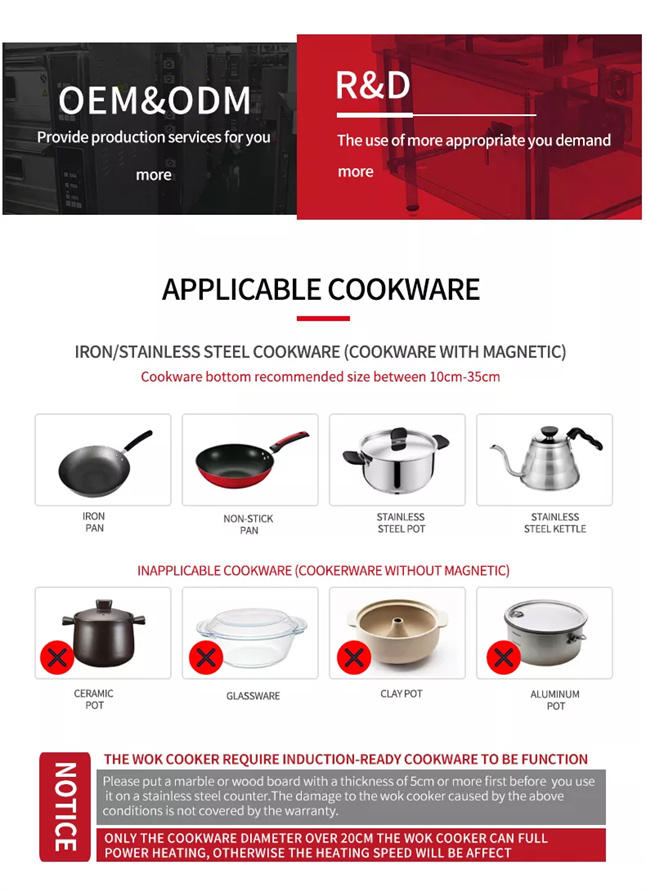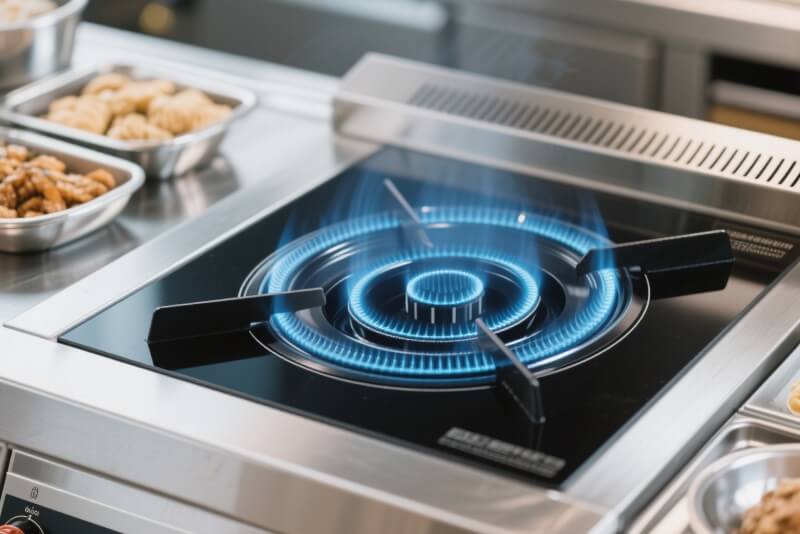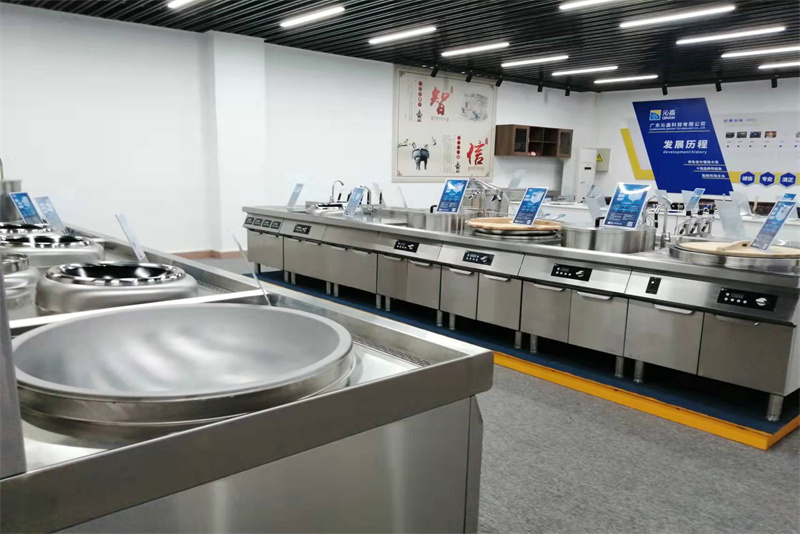Opening a Chinese restaurant in Europe presents many opportunities and challenges. To run the restaurant…

Commercial Induction Cookers Save Energy while Ensuring Good Cooking Results?
In commercial kitchens, the balance between energy saving and cooking results of induction cookers is a core issue that many catering companies are concerned about. Here are some specific methods and suggestions to help you ensure that induction cookers save energy while maintaining excellent cooking results:
1. Optimize equipment design and technology
The energy-saving effect and cooking performance of induction cookers depend highly on their design and core technology. Here are a few key points:
(1) High thermal efficiency design
The thermal efficiency of induction cookers can usually reach more than 90%, much higher than the 30%-40% of traditional gas stoves. Its working principle is to heat the bottom of the pot through electromagnetic induction directly, reducing the problem of heat loss to the air. Ensure that the equipment uses high-quality coils and control chips to maximize thermal efficiency.
(2) Precision temperature control system
The temperature control accuracy of the induction cooker directly affects the cooking effect. Choosing equipment equipped with a high-precision temperature control system can achieve a temperature control range of ±1℃. For example, when cooking noodles, precise temperature control can prevent noodles from being overcooked or undercooked while reducing unnecessary energy waste.
(3) Intelligent power adjustment
The power of the induction cooker can be flexibly adjusted according to cooking needs. For example, high power can be used for rapid heating when boiling water, while switching to low power mode when stewing or keeping warm. This intelligent adjustment not only saves energy but also ensures the stability of the cooking process.
2. Choose the right pot
The choice of pot is crucial to the energy-saving effect and cooking performance of the induction cooker. Here are a few suggestions:
(1) Flat-bottomed pots
The induction cooker needs to be in full contact with the bottom of the pot to achieve efficient heating. Choosing pots with a flat bottom and uniform thickness can ensure uniform heat distribution and reduce the problem of local overheating or insufficient heating.
(2) Magnetic conductive materials
Induction cookers can only heat magnetic conductive materials (such as iron and stainless steel), while non-magnetic conductive materials such as copper and aluminum cannot be used. Choosing high-quality magnetic conductive pots can improve heating efficiency and reduce energy waste.
(3) Matching pot size
The size of the pot should match the heating area of the induction cooker. Oversized pots will cause heat to be concentrated in the center area, while undersized pots cannot fully utilize the heating area. Choosing pots of the right size can improve energy utilization.

3. Reasonable setting of cooking parameters
According to different dishes and cooking requirements, reasonable setting of the power and temperature of the induction cooker is the key to balancing energy saving and cooking effect.
(1) Staged cooking
Many dishes need to be cooked in stages, such as first using high power for rapid heating and then using low power for slow cooking. For example:
Cooking noodles: Rapidly boil at high power, then switch to medium power to maintain water temperature to avoid over-boiling and wasting energy.
Cooking soup: Rapidly boil at high power and then switch to low power for slow cooking, which can save energy and ensure the taste and nutrition of the soup.
(2) Preheating and heat preservation
For dishes that require a long cooking time, you can preheat the pot in advance to reduce the heating time. At the same time, use the heat preservation function of the induction cooker to avoid energy waste caused by repeated heating.
4. Optimizing kitchen operation procedures
The kitchen operation procedures directly affect the efficiency and energy-saving effect of the induction cooker.
(1) Centralized cooking
Try to concentrate on dishes that require high-temperature cooking in the same period to reduce energy consumption caused by frequent starting and stopping of equipment. For example, high-temperature cooking tasks such as stir-frying and boiling noodles can be concentrated during peak hours, while low-power cooking tasks (such as making soup and keeping warm) can be dispersed to other hours.
(2) Reducing idling time
Avoid running the induction cooker without a pot or with an empty pot, which will result in a lot of energy. The kitchen staff should develop good operating habits to ensure that the equipment is always matched with pots when in use.
(3) Regular cleaning and maintenance
The cleaning and maintenance of the induction cooker directly affect its performance and life. Regularly clean the coil and heat dissipation system to ensure smooth operation of the equipment and reduce energy waste caused by malfunctions.
5. Utilize intelligent functions
Modern induction cookers are usually equipped with intelligent functions, which can help further optimize energy saving and cooking performance.
(1) Automatic cooking programs
Many induction cookers provide preset automatic cooking programs, such as “boiling noodles,” “making soup,” “stir-frying,” etc. These programs automatically adjust the power and temperature according to different cooking needs, which not only ensures the cooking effect but also maximizes energy saving.
(2) Remote monitoring and data analysis
Some high-end induction cookers support the Internet of Things function, which can monitor the operating status and energy consumption data of the equipment in real-time. By analyzing this data, you can optimize the energy use strategy of the kitchen and further improve the energy-saving effect.
6. Kitchen environment optimization
The overall environment of the kitchen will also affect the energy-saving effect and cooking performance of the induction cooker.
(1) Good ventilation system
The induction cooker will generate a certain amount of heat when it is running. A good ventilation system can extract the hot air in time to prevent the kitchen temperature from becoming too high, thereby reducing the burden on the air conditioning system.
(2) Reasonable equipment layout
The induction cooker should be arranged separately from other high-temperature equipment (such as fryers and griddles) to avoid heat interference and ensure the comfort and safety of operators.
(3) Avoid frequently switching equipment on and off of equipment
Frequent switching on and off of induction cookers will result in a lot of energy waste. Try to keep the equipment in standby mode instead of completely turning it off, which can reduce energy consumption during startup.
-
 Портативна ресторанна індукційна фритюрниця з двома кошиками LT-TZL-B105
Портативна ресторанна індукційна фритюрниця з двома кошиками LT-TZL-B105 -
 Настільна індукційна плита Wok LT-TPA-B135 з 2 конфорками для ресторанів LT-TPA-B135
Настільна індукційна плита Wok LT-TPA-B135 з 2 конфорками для ресторанів LT-TPA-B135 -
 Настільна індукційна плита на 2 конфорки для ресторану LT-TPP-B135
Настільна індукційна плита на 2 конфорки для ресторану LT-TPP-B135 -
 Суцільноскляна комерційна вбудовувана індукційна варильна поверхня LT-QPM-C335
Суцільноскляна комерційна вбудовувана індукційна варильна поверхня LT-QPM-C335 -
 Настільна комерційна індукційна плита на 6 конфорок LT-TBZ300VI-B135
Настільна комерційна індукційна плита на 6 конфорок LT-TBZ300VI-B135 -
 Індукційні сковороди для ресторанів LT-TAM-B505 потужністю 5000 Вт зі стільницею LT-TAM-B505
Індукційні сковороди для ресторанів LT-TAM-B505 потужністю 5000 Вт зі стільницею LT-TAM-B505 -
 Індукційна варильна поверхня для ресторану 3500 Вт LT-TPM-B535
Індукційна варильна поверхня для ресторану 3500 Вт LT-TPM-B535 -
 Індукційна плита LT-TPM-B135 на 3500 Вт для комерційних стільниць LT-TPM-B135
Індукційна плита LT-TPM-B135 на 3500 Вт для комерційних стільниць LT-TPM-B135 -
 Настільна індукційна варильна поверхня на 4 конфорки 3500 Вт LT-TBZ300IV-B135
Настільна індукційна варильна поверхня на 4 конфорки 3500 Вт LT-TBZ300IV-B135
7. Training kitchen staff
The operating habits of kitchen staff directly affect the energy-saving effect and cooking performance of the equipment. Regularly train employees to ensure that they are familiar with the use of the equipment and energy-saving tips.
(1) Correct use of equipment
Train employees on how to select pots, set power and temperature, and use automatic cooking programs correctly.
(2) Energy-saving awareness training
Cultivate employees’ energy-saving awareness, such as avoiding idling, centralized cooking, and timely cleaning of equipment.
8. Case analysis: Energy-saving practice of a chain restaurant
After introducing an induction cooker, a chain restaurant achieved a win-win situation of energy saving and cooking effect through the following measures:
(1) Equipment selection
Choose an induction cooker with high thermal efficiency and precise temperature control, and equip it with an intelligent power adjustment function.
(2) Cookware optimization
Buy flat-bottomed cookware with good magnetic conductivity to ensure heating efficiency.
(3) Operation process improvement
Centralize cooking tasks during peak hours to reduce frequent equipment startup.
(4) Employee training
Regularly organize energy-saving operation training to ensure that every employee can use the equipment proficiently.
After these optimizations, the restaurant’s kitchen energy consumption was reduced by 35%, while the quality of dishes and customer satisfaction were significantly improved.
Conclusion
The energy-saving and cooking effects of the induction cooker are not in opposition but a win-win goal that can be achieved through technical optimization, reasonable operation, and management. As a commercial induction cooker manufacturer, we are committed to providing you with efficient, energy-saving, and high-performance equipment.
At the same time, through training and technical support, we help you build a more intelligent and sustainable commercial kitchen. Choosing our products is not only about energy-saving and efficient cooking tools but also the first step towards green kitchens and sustainable development.
automatic cooking machine automatic cooking machines bbq chip fryer commercial cooking equipment commercial drop in induction cooker commercial food steamer commercial induction cooker commercial induction cooktop комерційна індукційна фритюрниця commercial induction fryer commercial induction hob commercial induction soup cooker Комерційна індукційна пароварка commercial induction wok cooker commercial kitchen cookware food steamer hob induction cooker induction cookware INDUCTION FRYER induction grill induction hob iron wok kitchen equipment repair guide restaurangt equipment restaurant equipment stainless steel cookware user's guidance



This Post Has 0 Comments